Excavation Story


Excavation begun in 1954 at the Naniwa Palace Site uncovered the remains of two overlapping palaces: the Former Naniwa Palace, of the Asuka period and the Latter Naniwa Palace, of the Nara period. The excavations have yielded many academic findings that have rewritten Japanese ancient history. The site is in central Osaka. This initially posed a serious challenge to preserving the site, but persistent conservation efforts by chief archaeologist Prof. Tokutaro Yamane were ultimately successful.
An area of approximately 14.5 hectares was designated as a National Historic
Site. It is extremely rare for a such a large archaeological site to have been
preserved in the heart of a Japanese city.


1913 |
Nara-period Nokimaru eaves tiles were discovered at an Imperial Army facility under construction, and presented to the Society in 1916. 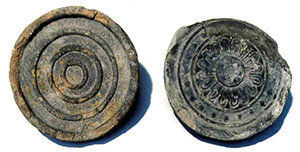
|
|---|---|
1954 |
After the discovery of ornamental roof tile fragments at a residential construction site at Hoenzaka the year before, the first excavations begin in the vicinity of the site.  |
1957-68 |
Excavations of the Former and Latter Imperial Domicile continue.  |
1961 |
Discovery of the Latter Imperial Audience Hall and its Rear Hall. 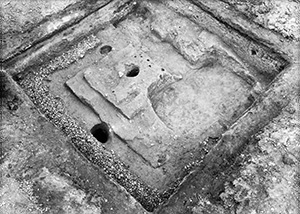 |
1962 |
A joint government office building was planned for construction in the area around the Former Imperial Audience Hall site, and the Association for the Protection of the Naniwa Palace Site was founded to conduct a preservation campaign. |
1964 |
The area of the Latter Imperial Audience Hall Compound and the Main Hall of the Imperial Domicile are designated as National Historic Sites (Designation No. 1). |
1969 |
Trial begins for the preservation of archaeological sites of the Eastern Government Offices. The dispute was settled in 1979. |
1970 |
Excavation of the entire Latter Imperial Audience Hall Compound. 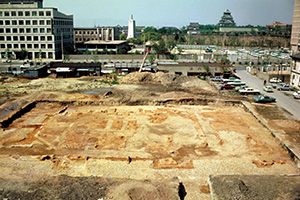 |
1971-76 |
Latter Imperial Audience Hall Compound historic site is equipped. 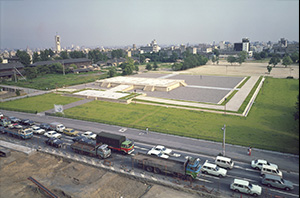 |
1974 |
The plan is revised to place the Hanshin Expressway, which crosses the Imperial Domicile area, at ground level. The remains of the central area are preserved. 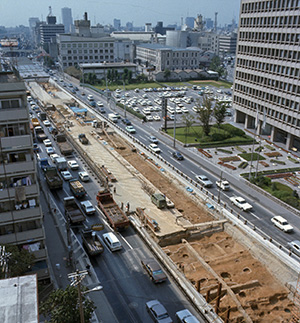 |
1976 |
Designation as National Historic Site added for Imperial Domicile and the State Halls Compound (Designation No. 2).  |
1986 |
Designation as National Historic Site for a portion of the State Halls Compound of Latter Naniwa Palace is added (Designation No. 3). |
1987 |
Discovery of large-scale warehouse complex from the Kofun period (Hoenzaka Site) in the Western Government Offices of the Early Imperial Domicile. A campaign begins to preserve the site. 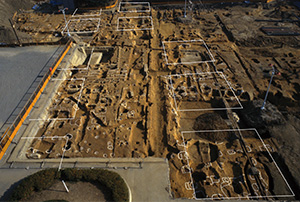 |
1993 |
Discovery of the Former Palace South Gate (Vermillion Bird Gate). 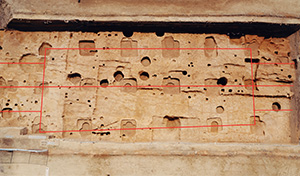 |
1997 |
Masonry water storage facility found northwest of the Western Government Offices of the Early Imperial Domicile. 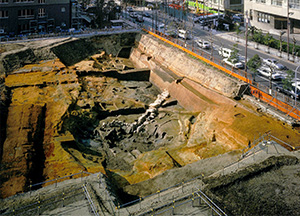 |
1999 |
Message tablet marked with the year 648 excavated in a valley north of the west section of the palace. 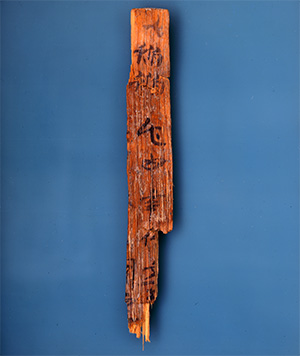
大阪府文化財センター提供 (原資料:大阪府教育委員会所蔵、大阪府指定文化財) |
2001 |
National Historic Site designation (Designation No. 4) added in response to discovery of Western Government Offices of the Former Imperial Domicile and a warehouse complex from the Kofun period. Historic site name is changed to Naniwa Palace and Hoenzaka Sites. Osaka Museum of History opens. |
2005 |
National Historic Site designation added for eastern area of State Halls and the western portion of the Imperial Domicile area (Designation No. 5). |
2005-06 |
Discovery of multistory structure northeast of the Former Eastern Government Offices. |
2007 |
Due to the above result, National Historic Site designation is added for northeastern section of Eastern Government Offices (Designation No. 6). |
2013 |
National Historic Site Designation added for south half of Former Eastern Government Offices (Designation No. 7). |
2022 |
Naniwa Palace Site Park P-PFI Project begins. 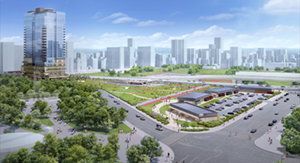 |
2023 |
New section confirmed further north of the Former Imperial Domicile Rear Hall. 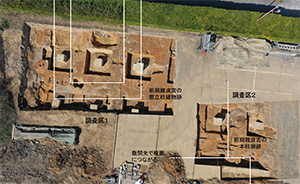
|
提供元記載の無い写真は一般財団法人大阪市文化財協会提供
Naniwa Palace Site Historical Designation and Fiscal Year

